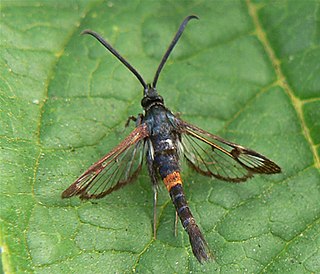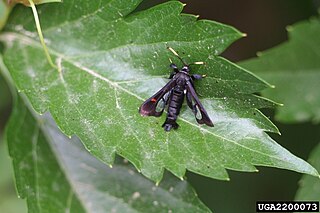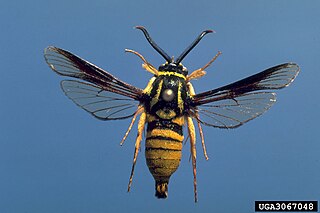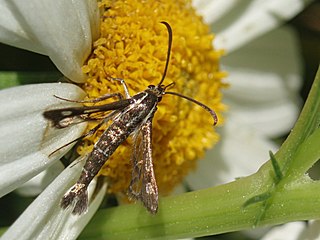
The ash borer, or lilac borer, is a clearwing moth in the family Sesiidae. It is found throughout North America and can be a pest of ash and lilac.

Synanthedon myopaeformis is a moth of the family Sesiidae and the order Lepidoptera. In Europe it is known as the red-belted clearwing and in North America as the apple clearwing moth. The larvae create galleries under the bark of fruit trees, especially old trees with damaged trunks. During this process, the larvae cause significant damage to host trees. Particular attention has been paid to the damage they cause to apple trees. Their status as a pest of apple orchards has led to many research projects aimed at controlling populations of the moth. This moth is native to Europe, the Near East and North Africa. Recently, the moth was introduced into North America, being first detected in Canada in 2005. There are several organisms that threaten the larvae, including parasitoids, nematodes, and bacteria.

Synanthedon tipuliformis, known as the currant clearwing, is a moth of the family Sesiidae. It is endemic to the Palearctic realm, but is an invasive species in the Nearctic realm and the Australasian realm.

Synanthedon vespiformis, the yellow-legged clearwing, is a moth of the family Sesiidae. It is found in the Palearctic realm.

Paranthrene dollii, Doll's clearwing, cottonwood clearwing or poplar borer, is a moth of the family Sesiidae. It is found in North America.
Ichneumenoptera chrysophanes, the clearwing persimmon borer, is a moth of the family Sesiidae. It is found from Cairns in Queensland to Canberra in the Australian Capital Territory.

Bembecia ichneumoniformis, the six-belted clearwing, is a moth of the family Sesiidae.

Albuna is a genus of moths in the family Sesiidae.

Synanthedon andrenaeformis, the orange-tailed clearwing, is a moth of the family Sesiidae. It is known from most of Europe. It is also present in the Near East.

Paranthrene simulans, the red oak clearwing borer, hornet clearwing or oak clearwing borer, is a moth of the family Sesiidae. It is found in eastern North America, from Nova Scotia to Florida, west to Minnesota, Missouri and Mississippi.

Synanthedon rileyana, the horsenettle borer or Riley's clearwing moth, is a moth of the family Sesiidae. It is found in the United States, including Arkansas, Arizona, Missouri, Oklahoma, North Carolina and Pennsylvania.

Sesia tibialis, the American hornet moth, poplar clearwing borer or cottonwood crown borer, is a moth of the family Sesiidae. It is known from North America, including British Columbia, Colorado, Utah, Michigan, Montana, Washington, California and Arizona.

Chamaesphecia hungarica, the Hungarian clearwing moth, is a moth of the family Sesiidae. It is native to the south-eastern Czech Republic and Slovakia, Austria, Hungary, Serbia and Croatia. It was originally approved for introduction into the United States in 1993. It has been released at several leafy spurge-infested sites in Montana and North Dakota.

Pyropteron muscaeforme, the thrift clearwing, is a moth of the family Sesiidae. It is known from most of Europe. A small member of its genus, the wingspan is 15–18 mm. It is further distinguished by narrow clear (transparent) spaces on the blackish, or bronzy, forewings. There are three whitish bands on the body, and traces of a whitish line along the middle of the back.

Synanthedon formicaeformis, the red-tipped clearwing, is a moth of the family Sesiidae and can be found in all of Europe, the eastern Palearctic realm, and the Near East. The larvae sometimes form pear-shaped galls on willows. It was first described by Eugenius Johann Christoph Esper in 1783.
Synanthedon conopiformis, Dale's oak clearwing, is a moth of the family Sesiidae. It is found in almost all of Europe, except the north.
Synanthedon flaviventris, the sallow clearwing, is a moth of the family Sesiidae. The larvae form pear-shaped galls on sallows.

Synanthedon scoliaeformis, the Welsh clearwing, is a moth of the family Sesiidae. It is found from almost all of Europe, east through Russia to Japan.

Albuna pyramidalis, the fireweed clearwing moth, is a species of clearwing moth in the family Sesiidae.


















